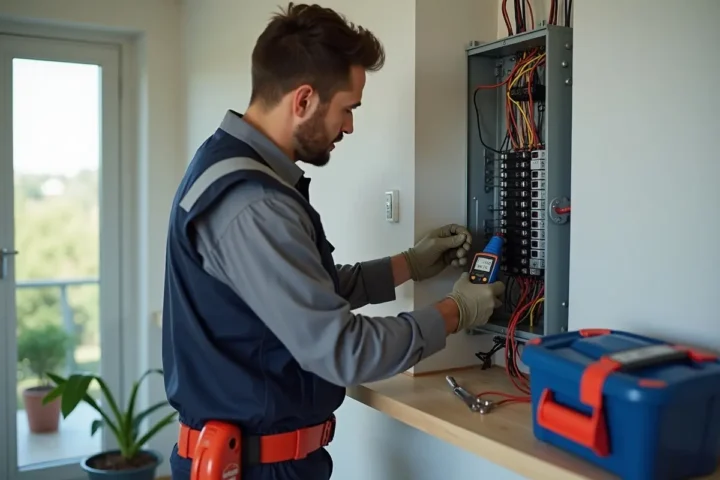When DIY Isn’t Enough: Key Times to Call an Electrician
Are you someone who’s handy around the house, confident with a toolbox, and willing to take on some DIY? That’s great; after all, a lot of small tasks around the home can be tackled with a bit of effort and a quick YouTube tutorial.
But when it comes to electricity, it’s a different story. Knowing when to put down the tools and call a professional is crucial—not just for the success of the project, but for the safety of you and your home.

So, how do you know when it’s time to call an electrician? Here are some situations where a DIY approach just isn’t enough.
1. Flickering Lights
Have you noticed that your lights flicker, even when the bulbs are brand new? It might seem like a small issue or even something you can ignore, but this flickering can signal something more serious. If it happens often, it could point to a loose connection or faulty wiring. In some cases, it might mean your electrical system is overloaded, especially if it happens when you’re running multiple appliances. If the issue stems from the service head, meter or supply connection — areas handled by specialised contractors — it is worth consulting resources that have the level 2 electrical services explained in order to understand when a Level 2 electrician is required.
Fixing this yourself isn’t a great idea. Flickering lights due to electrical problems can lead to overheating and potentially fire hazards. An electrician will identify the root cause and ensure your wiring is safe and secure.
2. Outlets That Feel Warm
If you touch an outlet and it feels warm, that’s a sign that something’s not right. Outlets and light switches should generally be cool to the touch. If they’re warm—or worse, if you can smell burning or see scorch marks—don’t wait. This could mean there’s an overloaded circuit, damaged wiring, or even a hidden issue within your electrical system that needs immediate attention.
Warm outlets can lead to fires, and any time you’re dealing with potential overheating in an electrical component, it’s time to bring in the professionals for residential electrical services Auckland. An electrician can diagnose and fix the issue properly, keeping your home safe.
3. Frequently Tripping Circuit Breakers
Circuit breakers are your electrical system’s safety feature, protecting it from overloads and short circuits. When you plug in too many devices, the breaker trips to prevent overheating. But if you find yourself heading to the breaker box more often than usual, it’s more than just an inconvenience—it’s a sign that something might be wrong.
This could be due to outdated wiring, an overloaded panel, or a faulty breaker. While resetting a breaker is easy, diagnosing and fixing the cause of frequent tripping is not. Electricians can assess your entire system and, if necessary, upgrade or repair it for a safer, more reliable setup.
4. Outdated or Non-Grounded Outlets
Many older homes still have two-pronged, non-grounded outlets. These outlets are not only inconvenient but also unsafe, especially if you’re plugging in modern appliances. Grounding provides an essential safety measure by directing excess electrical charges away from your appliances and into the earth. Without it, the risk of electrical shock and damage to electronics increases significantly.
Installing grounded outlets involves more than just swapping out the faceplate—it often requires rewiring, which should only be done by a licensed electrician. An electrician can upgrade your outlets to include GFCIs (ground fault circuit interrupters), which offer added protection in areas where water is present, like kitchens and bathrooms.
5. Adding New Appliances
Bought a new fridge or air conditioning unit? Fantastic. But don’t assume it’s as simple as plugging it in. Larger appliances often need dedicated circuits to handle their power demands. Connecting them to a regular outlet could overload the system and even lead to an electrical fire.
An electrician can assess your setup and install the necessary circuits, so your new appliance runs smoothly and safely without putting excess strain on your electrical panel.
6. Installing or Replacing Light Fixtures
Replacing a light fixture might look like a straightforward task, especially if you’re just switching out one for another. However, light fixtures, particularly larger or more complex installations, need correct wiring to handle the fixture’s wattage and load. If done incorrectly, there’s a risk of short circuits, overheating, and even electrical shocks.
Professional electricians have the tools and expertise to make sure the installation meets electrical codes. They’ll also make sure that everything is grounded correctly, reducing the risk of electrical faults and ensuring the fixture operates safely.
7. Power Surges and Circuit Damage
Have you noticed that your appliances sometimes flicker or behave strangely after a power surge? Power surges can be caused by lightning strikes, power outages, and even large appliances cycling on and off. These surges can harm sensitive electronics and damage your home’s electrical system over time.
If you’re experiencing frequent power surges, it’s best to call an electrician to assess the situation. They can install surge protectors for your entire home and inspect your wiring for any signs of wear or damage that might be contributing to these surges.
8. Renovating or Rewiring Rooms
Planning a remodel? If you’re renovating a room or adding new spaces, electrical work is likely part of the plan. Even if you’re comfortable with basic electrical tasks, major changes, like rewiring or installing new outlets, should be left to professionals. Not only does it involve working with live wires, but it’s also essential to meet electrical codes to pass inspections.
Electricians have the know-how to handle the complex rewiring safely, ensuring everything is up to standard and your home’s electrical infrastructure can handle the new load.
Searching for an “electrician near me” can help you find reliable local professionals to complete your project efficiently and safely.
When Safety Matters, Bring in the Experts
Electricity isn’t something to take chances with. While a bit of DIY is fine for tasks around the house, electrical work is on another level entirely. If you’re ever unsure, it’s always better to consult a professional electrician. They’ll bring the experience, tools, and training needed to handle complex and hazardous situations safely.
It’s your home and your safety on the line—sometimes, DIY just doesn’t cut it.


